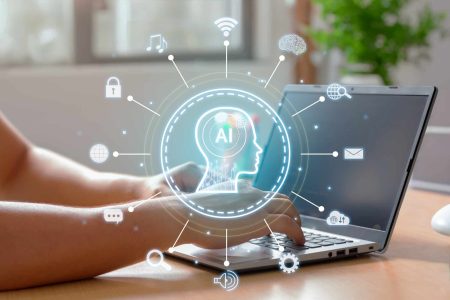Artificial Intelligence (AI) has transformed various industries, and at the heart of this revolution are AI agents. These autonomous entities perform a wide range of tasks, demonstrating their significant importance in today’s technological landscape. By exploring the different types of AI agents—such as reactive agents, deliberative agents, and learning agents—we gain insight into their diverse functionalities. Understanding how these agents operate, from reactive agents that respond to environmental stimuli to deliberative agents that plan and make decisions, and learning agents that adapt over time, showcases their evolving capabilities. Multi-agent systems combine these individual agents to perform complex tasks collaboratively, amplifying their utility. As AI agents find applications in real-world scenarios, ranging from customer service to autonomous vehicles, it becomes crucial to consider the ethical implications of their use. Additionally, the development of AI agents comes with its own set of challenges, which must be addressed to ensure their responsible deployment. This comprehensive guide will delve into all these aspects, offering a detailed understanding of AI agents and their pivotal role in shaping the future.
Content
Introduction to AI Agents
Defining AI Agents
Artificial Intelligence agents, or AI agents, are autonomous entities equipped with the capability to perceive their environment and take actions to achieve specific goals. Unlike simple software programs, AI agents operate with a higher degree of independence, adapting to new information and making decisions without constant human intervention. These agents use sensors to collect data from their surroundings and actuators to perform actions based on their internal algorithms and learned knowledge. The goal of an AI agent is to optimize performance in various environments, ranging from virtual spaces like video games to physical settings such as robotics and smart home systems. By leveraging advanced computational models and data, AI agents can address complex problems more efficiently and accurately than traditional methods.
The Evolution of AI Agents
The concept of AI agents has evolved significantly since its inception, driven by advancements in computer science and artificial intelligence research. Early AI agents were relatively simple, operating in controlled environments with predefined rules. Over time, they have become more sophisticated, incorporating machine learning and neural networks to improve their decision-making processes. This evolution has enabled AI agents to handle unpredictability and complexity in dynamic environments, making them highly valuable in real-world applications. Modern AI agents can now learn from past experiences, predict future outcomes, and adapt to changing conditions. This progression has broadened the scope of their applications, from autonomous vehicles and personal assistants to industrial automation and healthcare diagnostics.
Key Characteristics of AI Agents
AI agents possess several key characteristics that distinguish them from traditional software programs. Autonomy is one of the most fundamental traits, allowing agents to operate independently without constant human oversight. Adaptability is another critical characteristic, enabling AI agents to learn from their interactions with the environment and improve their performance over time. Additionally, AI agents demonstrate the ability to sense their surroundings through sensors, process the gathered information, and take appropriate actions through actuators. Goal-orientation is also a defining feature, with AI agents programmed to achieve specific objectives efficiently. These characteristics collectively empower AI agents to perform complex tasks in various domains, enhancing their effectiveness and versatility in modern technological applications.
Types of AI Agents
Reactive agents are the simplest form of AI agents, designed to respond directly to environmental stimuli without maintaining an internal model of the world. These agents operate based on predefined rules, making decisions by mapping current perceptions to actions. Due to their limited scope, reactive agents are often employed in applications where tasks are straightforward and environments are well-defined. For example, they are commonly used in video games for NPC behavior or in simple robotic systems that require basic obstacle avoidance. While their lack of memory and anticipation capabilities restricts their applicability in more complex scenarios, reactive agents excel in scenarios where speed and efficiency are critical.
Deliberative agents, on the other hand, possess the capability to plan and make decisions based on an internal model of their environment. These agents can predict potential future states and sequences of actions, allowing them to execute more sophisticated tasks. They operate using symbolic reasoning and often employ search algorithms to navigate through possible action plans. This makes deliberative agents well-suited for applications that require forward-thinking, such as autonomous navigation in unfamiliar terrains, strategic game playing, or complex problem-solving tasks. While deliberative agents offer greater flexibility and strategic depth compared to reactive agents, they typically require more computational resources, making them slower in response times.
Learning agents bring a higher degree of adaptability to AI systems by incorporating machine learning techniques to improve their performance over time. Unlike reactive and deliberative agents, learning agents can modify their behavior based on experiences and new data inputs. They utilize various learning paradigms, such as supervised learning, unsupervised learning, and reinforcement learning, to optimize their actions toward achieving specific goals. This adaptability allows learning agents to handle a wide range of dynamic and unpredictable environments effectively. For instance, they are used in recommendation systems that improve suggestions based on user preferences, autonomous vehicles that learn to navigate through traffic, and smart assistants that understand and predict user needs better over time. The continuous improvement and evolving capabilities of learning agents make them integral to the advancement of AI technologies.
Reactive Agents Explained
Basic Architecture of Reactive Agents
Reactive agents follow a straightforward “sense-act” architecture, where the agent perceives environmental inputs through sensors and immediately reacts by executing corresponding actions via actuators. This simple feedback loop eliminates the need for complex computations or internal representations of the environment. The pre-defined rules governing the agent’s behavior are typically encoded as condition-action pairs, also known as production rules. When a specific condition is sensed, a corresponding action is triggered. This architecture enables rapid responses to stimuli, making reactive agents highly efficient in time-sensitive applications like robotic control systems and real-time simulations. However, due to their lack of internal state or memory, reactive agents struggle in scenarios requiring long-term planning or adaptation to unforeseen changes.
Use Cases and Applications
Reactive agents are widely used in scenarios where the environment is static and well-understood, and tasks are repetitive and predictable. One prominent use case is in video game AI, where non-player characters (NPCs) exhibit specific behaviors in response to player actions, creating a more immersive gaming experience. In the realm of robotics, reactive agents are often implemented for tasks like simple navigation, object avoidance, and basic manipulations, where real-time responses are crucial. Another application is in automated industrial systems, such as assembly lines, where reactive agents manage repetitive actions, ensuring consistent and efficient operations. While their simplicity limits their adaptability, reactive agents excel in environments requiring consistent and rapid responses, providing reliable performance without complex computational overhead.
Limitations and Challenges
Despite their efficiency and simplicity, reactive agents face several limitations that constrain their utility in more complex scenarios. The primary drawback is their lack of memory and ability to learn from past interactions, which restricts them to immediate, context-less decisions. This incapacity to maintain an internal model of the world makes it difficult for reactive agents to handle tasks requiring long-term planning or adaptive behavior. Additionally, designing effective condition-action rules can be a daunting task, particularly in dynamic environments where numerous variables and edge cases must be considered. Reactive agents also struggle with scalability, as expanding their rule sets to accommodate more sophisticated behaviors can lead to increased complexity and decreased performance. These challenges underscore the need for more advanced AI agents in applications demanding higher-level cognitive functions and adaptability.
Transform your business with custom AI solutions from a leading Artificial Intelligence Agency.
Deliberative Agents and Their Functions
Deliberative agents distinguish themselves by their capacity to plan and make informed decisions based on an internal representation of their environment. This capability hinges on their use of symbolic reasoning, which allows them to model their surroundings and anticipate future states. By constructing and evaluating potential sequences of actions, deliberative agents can choose the most effective course of action to achieve their goals. This planning process often involves sophisticated algorithms, such as A* search or Dijkstra’s algorithm, which navigate through decision trees to find optimal solutions. This foresight and strategic planning enable deliberative agents to excel in complex and dynamic environments where simple reactive behaviors would fall short.
An essential component of deliberative agents is their ability to balance immediate actions with long-term objectives. This ability to prioritize actions based on broader goals sets them apart from reactive agents, who are limited to short-sighted responses. Deliberative agents maintain a goal-oriented behavior through mechanisms such as goal stacking and task scheduling. These mechanisms allow the agent to manage multiple objectives simultaneously, switching between tasks as priorities shift. For example, a deliberative agent in a home automation system could manage energy consumption, security, and user comfort by strategically planning actions in response to changes in household conditions and long-term efficiency goals.
Deliberative agents also incorporate feedback mechanisms, enabling them to adjust their strategies based on outcomes and new information. This feedback loop helps enhance their performance over time, making them more adept at handling evolving challenges. Such adaptability is crucial in fields like autonomous navigation, where agents must navigate unpredictable terrains while avoiding obstacles and reaching their destinations. Real-world applications of deliberative agents span various domains, including robotics, logistics, and strategic game playing. In these scenarios, the agent’s ability to formulate and execute complex plans, coupled with real-time adaptability, provides significant advantages. By integrating detailed environmental models, advanced planning techniques, and adaptive feedback systems, deliberative agents demonstrate robust problem-solving capabilities critical for advanced AI applications.
Experience effortless, cost-effective social media management with AI technologies
Learning Agents and Their Capabilities
Machine Learning Techniques in Learning Agents
Learning agents leverage various machine learning techniques to enhance their decision-making capabilities and adapt to new environments. Supervised learning, for instance, involves training the agent using labeled datasets, enabling it to make accurate predictions based on input-output pairs. Unsupervised learning, on the other hand, allows agents to identify patterns and structures in unlabeled data, making it useful for anomaly detection and clustering tasks. Additionally, reinforcement learning is frequently utilized, where an agent learns optimal actions through trial and error, receiving rewards or penalties based on the outcomes of its actions. By employing these techniques, learning agents can continuously improve their performance, making them highly effective in dynamic and unpredictable settings.
Adaptive Learning and Behavior Modification
One of the key strengths of learning agents is their ability to adaptively modify their behavior based on new information and past experiences. Unlike reactive agents, which rely on static rules, learning agents continuously update their decision-making models to reflect changes in their environment. This adaptability is achieved through iterative learning processes, where the agent refines its strategies by evaluating the success of previous actions. For example, in autonomous driving, a learning agent can adapt to diverse driving conditions by learning from a vast array of traffic scenarios. Such adaptive behavior modification ensures that learning agents remain relevant and effective even as their environment evolves, making them indispensable for applications demanding ongoing improvement and flexibility.
Real-World Applications of Learning Agents
Learning agents are increasingly being deployed in real-world applications, demonstrating their versatility and superior performance across various industries. In healthcare, for instance, learning agents assist in predictive analytics, identifying potential health risks based on patient data and improving diagnostic accuracy. In finance, these agents are used for algorithmic trading, where they analyze market trends and execute trades to maximize returns. Autonomous systems, such as self-driving cars and drones, heavily rely on learning agents to navigate complex environments and make real-time decisions. Additionally, in customer service, learning agents power chatbots that enhance user interactions by understanding and responding to customer queries more effectively over time. These practical applications highlight the transformative potential of learning agents in driving innovation and efficiency in multiple fields.
The Role of Multi-Agent Systems
Multi-agent systems (MAS) consist of multiple interacting AI agents that collaborate or compete to achieve individual or shared goals. The coordination among these agents is fundamental to their effectiveness, allowing them to handle complex tasks that would be impractical for a single agent to manage. These systems can be designed to work in a decentralized manner, where each agent operates independently, or in a centralized manner, where a central controller orchestrates the actions of all agents. The distributed nature of MAS provides robustness and scalability, enabling the system to continue functioning effectively even if some agents fail or new ones are added. This architecture is particularly beneficial in dynamic and large-scale environments such as traffic management, where agents can individually manage different intersections while collectively optimizing overall flow.
One of the critical advantages of multi-agent systems is their ability to solve problems through emergent behavior, which arises from the local interactions of individual agents. This emergent behavior can lead to innovative solutions that are not explicitly programmed into the system. For example, in swarm robotics, simple robots following basic rules can collectively perform complex tasks such as search and rescue missions or environmental monitoring. By leveraging the principles of self-organization, multi-agent systems can adapt to changing conditions and find efficient solutions to problems without direct human intervention. This flexibility makes MAS an attractive option for applications requiring high adaptability and resilience.
In addition to their problem-solving capabilities, multi-agent systems play a significant role in simulating social and economic processes. They are used to model and analyze the behavior of individuals within a society, providing valuable insights into phenomena such as market dynamics, crowd behavior, and the spread of information or diseases. These simulations help researchers and policymakers understand and predict the outcomes of various interventions, leading to more informed decision-making. Furthermore, in the realm of artificial intelligence, MAS are instrumental in studying the principles of cooperation, competition, and negotiation among autonomous agents, enhancing our understanding of complex adaptive systems. By replicating real-world interactions, multi-agent systems contribute to the advancement of AI research and practical applications.
Elevate your business with DIGITALON AI’s custom AI services and solutions.
AI Agents in Real-World Applications
Healthcare and Medical Diagnosis
AI agents are revolutionizing healthcare by enhancing diagnostic accuracy and patient care. These agents analyze vast amounts of medical data, such as electronic health records and medical images, to detect patterns and predict health outcomes. Machine learning algorithms enable AI agents to identify diseases at an early stage, facilitating timely intervention and personalized treatment plans. For instance, AI-powered diagnostic tools can accurately identify conditions like cancer, heart disease, and neurological disorders, often exceeding human performance. Additionally, AI agents assist in drug discovery by analyzing biochemical data and predicting the efficacy of new compounds. By automating routine tasks and providing data-driven insights, AI agents significantly improve the efficiency and effectiveness of healthcare delivery, ultimately leading to better patient outcomes.
Autonomous Vehicles and Transportation
AI agents are at the forefront of the autonomous vehicle revolution, contributing to safer and more efficient transportation systems. These agents process data from sensors and cameras to navigate complex driving environments, make real-time decisions, and avoid obstacles. Through machine learning and decision-making algorithms, autonomous vehicles can adapt to varying traffic conditions, weather, and road surfaces. AI agents also enable advanced driver-assistance systems (ADAS) in non-autonomous vehicles, such as lane-keeping assistance, adaptive cruise control, and automatic emergency braking, enhancing driving safety. Beyond individual vehicles, AI agents optimize traffic flow by coordinating with traffic management systems, reducing congestion and emissions. The integration of AI agents into transportation is transforming mobility, providing significant social, economic, and environmental benefits.
Retail and Customer Service
In the retail sector, AI agents enhance the shopping experience and streamline operations through personalized recommendations, inventory management, and customer service automation. E-commerce platforms use AI-driven recommendation engines to suggest products tailored to individual preferences, increasing customer satisfaction and sales. In physical stores, AI agents optimize inventory by predicting demand, reducing overstock and stockouts. Chatbots and virtual assistants, powered by natural language processing, provide instant customer support, handling inquiries, and resolving issues efficiently. These AI agents also analyze customer feedback and sentiment to inform business strategies and improve services. By leveraging AI, retailers can offer more personalized, responsive, and efficient services, driving customer loyalty and operational excellence.
Ethical Considerations for AI Agents
The deployment of AI agents raises significant ethical considerations, particularly concerning privacy and data security. As AI agents often require vast amounts of data to function effectively, they can inadvertently infringe on individuals’ privacy. For instance, personal information collected through smart devices or online interactions might be used without explicit consent, raising concerns about data ownership and user privacy. Additionally, the risk of data breaches poses a significant threat, as sensitive information could be exposed to malicious actors. Ensuring that AI agents adhere to stringent data protection protocols and respecting user consent are critical measures to address these ethical challenges. Developing transparent data usage policies and employing robust encryption techniques can help mitigate privacy and security risks associated with AI agents.
Another crucial ethical consideration is the potential for bias in AI agents. AI systems are trained on historical data, which may contain inherent biases reflecting societal prejudices. Consequently, AI agents might perpetuate or even exacerbate these biases, leading to unfair or discriminatory outcomes. For example, biased training data in hiring algorithms can result in unfair hiring practices that disadvantage certain demographic groups. Addressing this issue requires a multifaceted approach, including diversifying training data, implementing fairness-aware algorithms, and conducting regular audits to identify and mitigate biases. By fostering inclusivity and fairness in AI development and deployment, we can create more equitable AI systems that serve all individuals impartially.
The ethical implications of AI agents also encompass accountability and transparency. When AI agents make decisions that impact people’s lives, it is essential to ensure that these decisions are transparent and accountable. This includes providing clear explanations for AI-driven decisions, enabling users to understand how and why a particular outcome was reached. Furthermore, establishing clear lines of accountability is vital, ensuring that developers, organizations, and stakeholders take responsibility for the actions and decisions of AI agents. This can be achieved through regulatory frameworks, industry standards, and ethical guidelines that outline the responsibilities of those involved in the development and deployment of AI systems. By prioritizing transparency and accountability, we can bolster public trust in AI technologies and ensure that they are used responsibly and ethically.
Challenges in Developing AI Agents
Data Quality and Availability
One of the foremost challenges in developing AI agents is ensuring access to high-quality and relevant data. AI agents rely heavily on data to learn and make decisions, but data can often be incomplete, noisy, or biased, affecting the agent’s performance and reliability. Obtaining large volumes of high-quality data from diverse and representative sources is crucial for training robust AI models. Furthermore, data privacy regulations and restrictions can limit the availability of data, complicating the development process. Ensuring that data is ethically sourced and properly annotated is also a significant task, requiring substantial time and resources. Addressing these issues involves implementing rigorous data curation practices, employing advanced data preprocessing techniques, and adhering to ethical data collection standards.
Computational Resources and Efficiency
The development and deployment of AI agents typically demand substantial computational resources, particularly for complex learning models and real-time decision-making tasks. Training sophisticated AI models, such as deep neural networks, requires vast amounts of computational power, often necessitating the use of specialized hardware like GPUs and TPUs. This need for high-performance computing can be a barrier for many organizations, especially smaller ones with limited budgets. Additionally, ensuring that AI agents can operate efficiently in real-time applications, such as autonomous vehicles or robotics, poses a significant challenge. To address these resource constraints, researchers and developers must focus on optimizing algorithms, utilizing cloud-based services, and exploring advancements in hardware acceleration to achieve the necessary computational efficiency.
Interpretable and Explainable AI
Another critical challenge in developing AI agents is ensuring that their decision-making processes are interpretable and explainable. Many AI models, particularly deep learning systems, function as “black boxes,” making it difficult to understand how specific decisions are made. This lack of transparency can hinder the trustworthiness and acceptance of AI agents, especially in high-stakes domains like healthcare, finance, or legal systems. To overcome this challenge, developers are increasingly focusing on creating interpretable AI models that provide clear, understandable explanations for their actions. Techniques such as feature importance analysis, model-agnostic interpretability methods, and visualization tools are being explored to enhance the transparency of AI systems. Ensuring interpretability not only builds user trust but also aids in identifying and mitigating biases and errors within AI agents.
Conclusion and Key Takeaways
Throughout this exploration of AI agents, it is evident that these autonomous entities play a critical role in advancing modern technology across various industries. By delving into the different types of AI agents, from reactive to deliberative and learning agents, we have highlighted their unique capabilities and contributions to solving complex problems. Reactive agents, with their quick response mechanisms, are suited for straightforward tasks, while deliberative and learning agents excel in more dynamic environments requiring strategic planning and adaptability. Understanding these distinctions helps in selecting the appropriate type of AI agent for specific applications, ensuring optimal performance and efficiency.
Multi-agent systems represent a significant advancement in AI technology, demonstrating how collaborative efforts among multiple agents can lead to innovative solutions and robust problem-solving techniques. These systems excel in environments where individual agents synergize to achieve common goals, as seen in applications ranging from traffic management to swarm robotics. The ability of multi-agent systems to operate in decentralized manners and their emergent behavior makes them particularly powerful in simulating complex real-world interactions and optimizing large-scale operations. This collective intelligence underscores the potential of AI agents to drive significant improvements in various fields.
However, the development and deployment of AI agents come with their unique set of challenges and ethical considerations. Ensuring data quality, managing computational resources, and fostering interpretable AI are critical hurdles to overcome. Additionally, addressing ethical concerns such as privacy, bias, and transparency is essential to build public trust and ensure responsible use of AI technologies. By prioritizing these aspects, developers can create more effective, trustworthy, and inclusive AI systems. As AI agents continue to evolve, they hold enormous potential to transform industries, enhance human capabilities, and address some of the most pressing issues facing society today.























